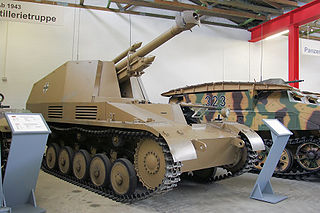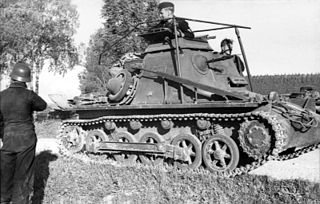
The Panzer II is the common name used for a family of German tanks used in World War II. The official German designation was Panzerkampfwagen II.

The Panzerkampfwagen III, commonly known as the Panzer III, was a medium tank developed in the 1930s by Germany, and was used extensively in World War II. The official German ordnance designation was Sd.Kfz. 141. It was intended to fight other armoured fighting vehicles and serve alongside and support the similar Panzer IV, which was originally designed for infantry support.

The Panzerkampfwagen IV, commonly known as the Panzer IV, is a German medium tank developed in the late 1930s and used extensively during the Second World War. Its ordnance inventory designation was Sd.Kfz. 161.

This article lists production figures for German armored fighting vehicles during the World War II era. Vehicles include tanks, self-propelled artillery, assault guns and tank destroyers.

The Panzerkampfwagen 38(t), originally known as the ČKD LT vz. 38, was a tank designed during the 1930s, which saw extensive service during World War II. Developed in Czechoslovakia by ČKD, the type was adopted by Nazi Germany following the annexation of Czechoslovakia. With the German Army and other Axis forces, the type saw service in the invasions of Poland, France and the USSR. Production ended in 1942, when its main armament was deemed inadequate. In all, over 1,400 Pz. 38(t)s were manufactured. The chassis of the Pz. 38(t) continued to be produced for the Marder III (1942–1944) with some of its components used in the later Jagdpanzer 38 (1944–1945) tank destroyer and its derivative vehicles.

The Sd.Kfz. 124 Wespe, also known as Leichte Feldhaubitze 18/2 auf Fahrgestell Panzerkampfwagen II (Sf.), is a German self-propelled gun developed and used during the Second World War. It was based on a modified Panzer II chassis.

The 15 cm sIG 33 (Sf) auf Panzerkampfwagen 38(t), also known as Grille was a series of self-propelled artillery vehicles used by Nazi Germany during World War II. The Grille series was based on the Czech Panzer 38(t) tank chassis and used a 15 cm sIG 33 infantry gun.

The 5 cm KwK 38 L/42(5 cm Kampfwagenkanone 38 L/42) was a German 50 mm calibre cannon used as the main armament of variants of the German Sd.Kfz. 141 Panzerkampfwagen III medium tank during the Second World War..
The Panzerkampfwagen I was a light tank produced in Germany in the 1930s. The Panzer I was built in several variants and was the basis for a number of variants listed below.

The Sd.Kfz. 234, was a family of armoured cars designed and built in Germany during World War II. The vehicles were lightly armoured, armed with a 20, 50 or 75 mm main gun, and powered by a Tatra V12 diesel engine. The Sd.Kfz. 234 broadly resembles the appearance of Sd.Kfz. 231 .

The kleiner Panzerbefehlswagen, known also by its ordnance inventory designation Sd.Kfz. 265, was the German Army's first purpose-designed armoured command vehicle; a type of armoured fighting vehicle designed to provide a tank unit commander with mobility and communications on the battlefield. A development of the Army's first mass-produced tank, the Panzer I Ausf. A, the Sd.Kfz. 265 saw considerable action during the early years of the war, serving in Panzer units through 1942 and with other formations until late in the war.

Sd.Kfz. 247 was an armored car used by the German armed forces during World War II.

The VK 16.02 Leopard was a planned German light reconnaissance vehicle designed from mid-1941 through to January 1943, with serial production scheduled for April 1943. It was intended to be the replacement of Panzer II Ausf. L "Luchs". The project was canceled in January 1943 before the first prototype was completed as it did not meet the requirements for 1944. A wooden mock up of the Waffenträger variant was produced.

The VK 30.01 (P) was the official designation for a heavy tank prototype proposed in Germany. Only two prototype chassis were built. The tank never entered serial production, but was further developed into the VK 45.01 Tiger (P). Porsche called it the Typ (Type) 100.

The Panzerkampfwagen I Ausf. F, also known as VK 18.01, was a German light tank from World War II. Despite the fact that it was designated as a modification of the light tank Panzer I, the VK.18.01 was a completely new vehicle, had almost nothing to do with it. The Pz.Kpfw.I Ausf.F was created in 1942 as a light tank designed to storm fortified lines. In that same year, 30 units were produced. From 1943 it was used for anti-guerrilla operations on the Eastern Front and in Yugoslavia. Thirty Ausf F tanks were built between April and December 1942, eight of which were sent to the Eastern Front for evaluation.

The Panzerkampfwagen I Ausf. C, also known by its prototype name VK 6.01, was a German light tank from the Second World War. Although the Panzer I Ausf. C was formally designated as a modification of the Panzer I, it was actually a completely new vehicle. This variant has little similarity with earlier Ausf. A and B variants - one of the main distinctions being the use of the Schachtellaufwerk inter-leaved track wheels which was used in many later German tanks during the war.

















